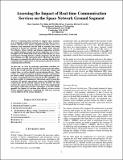Assessing the impact of real-time communication services on the space network ground segment
Author(s)
Net, Marc Sanchez; del Portillo, Inigo; Cameron, Bruce; Crawley, Edward; Sanchez Net, Marc; Del Portillo Barrios, Inigo; Cameron, Bruce Gregory; Crawley, Edward F; ... Show more Show less
DownloadAssessing the Impact of Real-Time Comm Services on the Space Network Ground Segment.pdf (1.014Mb)
OPEN_ACCESS_POLICY
Open Access Policy
Creative Commons Attribution-Noncommercial-Share Alike
Terms of use
Metadata
Show full item recordAbstract
Communication networks to support space missions were originally architected around non-real time data services. In fact, missions have always required real-time services (e.g. telemetry and command), but the bulk of scientific data being returned to Earth has typically been highly delay tolerant. Nevertheless, future robotic and human exploration activities are rapidly pushing towards low latency, high data rate services. Examples can be found both in the near Earth domain (e.g. near real-imagery through NASAs LANCE program) and the deep space domain (e.g. HD video from Mars). Therefore, the goal of this paper is to quantify the effect of new real-time high data rate communication requirements on the ground segment of current communication networks. To that end, we start by analyzing operational schedules for NASAs Space Network (SN) in order to characterize the utilization of the overall network in terms of total data volume and contact time, as well as identify current mission drivers. These results are compared against proposed network requirements for future robotic and human near Earth exploration activities in order to quantitatively assess gaps in the SN capabilities. Using these results, we implement a rule-based expert system that translates SN-specific operational contacts into high-level data requirements for the ground segment of the network. We then exercise the expert system in order to derive the requirements that future exploration activities will impose on the SN. Finally quantify the impact of real-time data delivery services across NASAs ground segment by computing the wide-area network cost for different levels of data timeliness.
Date issued
2016-03Department
Massachusetts Institute of Technology. System Design and Management Program; Massachusetts Institute of Technology. Department of Aeronautics and AstronauticsJournal
2016 IEEE Aerospace Conference
Publisher
Institute of Electrical and Electronics Engineers (IEEE)
Citation
Net, Marc Sanchez et al. “Assessing the Impact of Real-Time Communication Services on the Space Network Ground Segment.” IEEE, 2016. 1–13.
Version: Author's final manuscript
ISBN
978-1-4673-7676-1